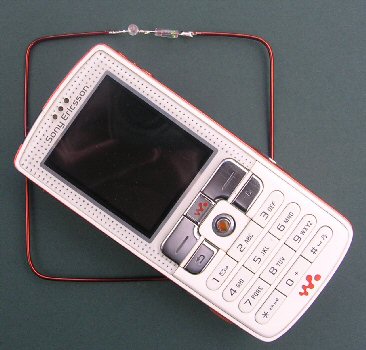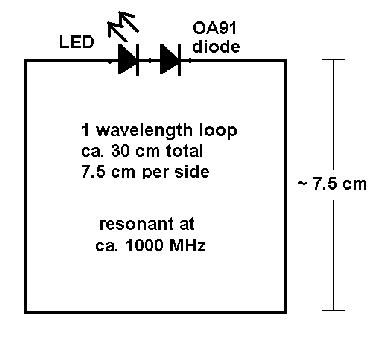

left: mobile phone radio wave detector and right: the simple schematic. Below: detail of the LED and germanium diode.




IMPORTANT NOTE: this device works very well on the old style mobile phones (as shown in the photo above). However, it does not always work well with modern smart phones. This may be because modern phones use higher frequencies, less power and use the power in a slightly different way (e.g. spread spectrum). Some smart phones do work and success may be due to the signal strength of the local mobile phone mast nearby. If you are in a low signal area the phone will create more power to ensure reliable communications. If you are in a very strong signal area (very near the local network) your phone will drop its output power and consiquently there will be less power to pick-up and to convert to a voltage to light the LED.
This is a very simple and cheap device that demonstrates mobile phones ('cell phones' or 'handies') generate radio waves. We have a 30 cm (7.5 cm per side) full-wavelength loop antenna (a 'Quad' to radio amateurs) connected to a germanium diode and a hyper-bright LED. The loop can be made of copper wire, thin sheet metal or a track on a pcb. The diodes need to be wired correctly. I think the germanium diode is needed as the LED probably has too great a self-capacitance to perform at the very high AC frequencies generated by the phone (ca. 900 or 1800 Hz) but will work well with the DC pulses from the germanium diode (which has a very small capacitance).
To show the mobile generates radio waves put the mobile near to the loop and dial a number (use a free phone number, e.g. your voice mail) or text. The radio waves will induce a voltage into the loop, large enough to light the LED. The LED will flash indicating the digital data being sent by the mobile phone transmitter. You may need to set your phone to 'GSM 900/1800' rather than the '3G' network in the settings menu.
parts:
germanium diode: Maplin Electronics: QH71N or Rapid Electronics: 47-3114
LED: Maplin Electronics: UF72P or Rapid Electronics: 55-0085

THE CREATIVE SCIENCE CENTRE
home | diary | whats on | CSC summary | latest news